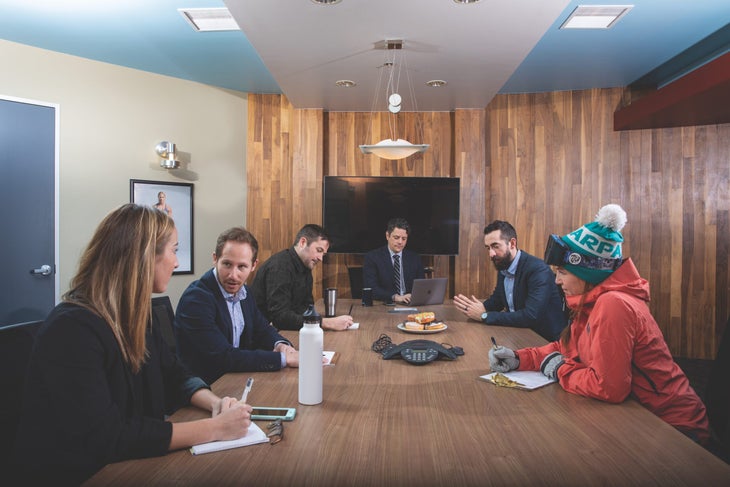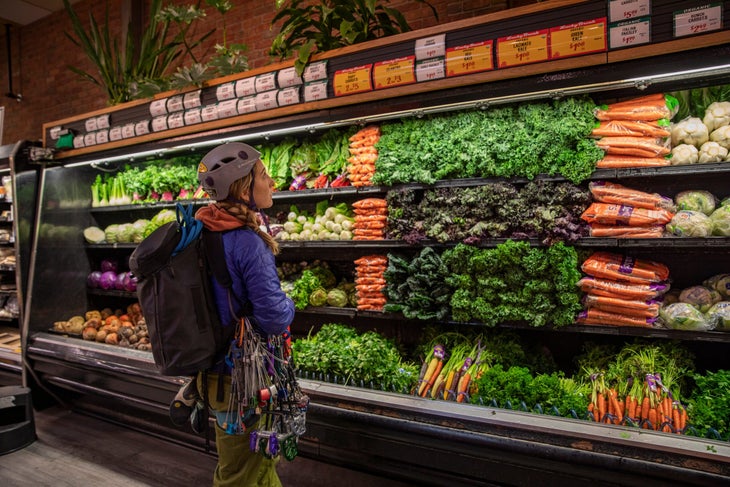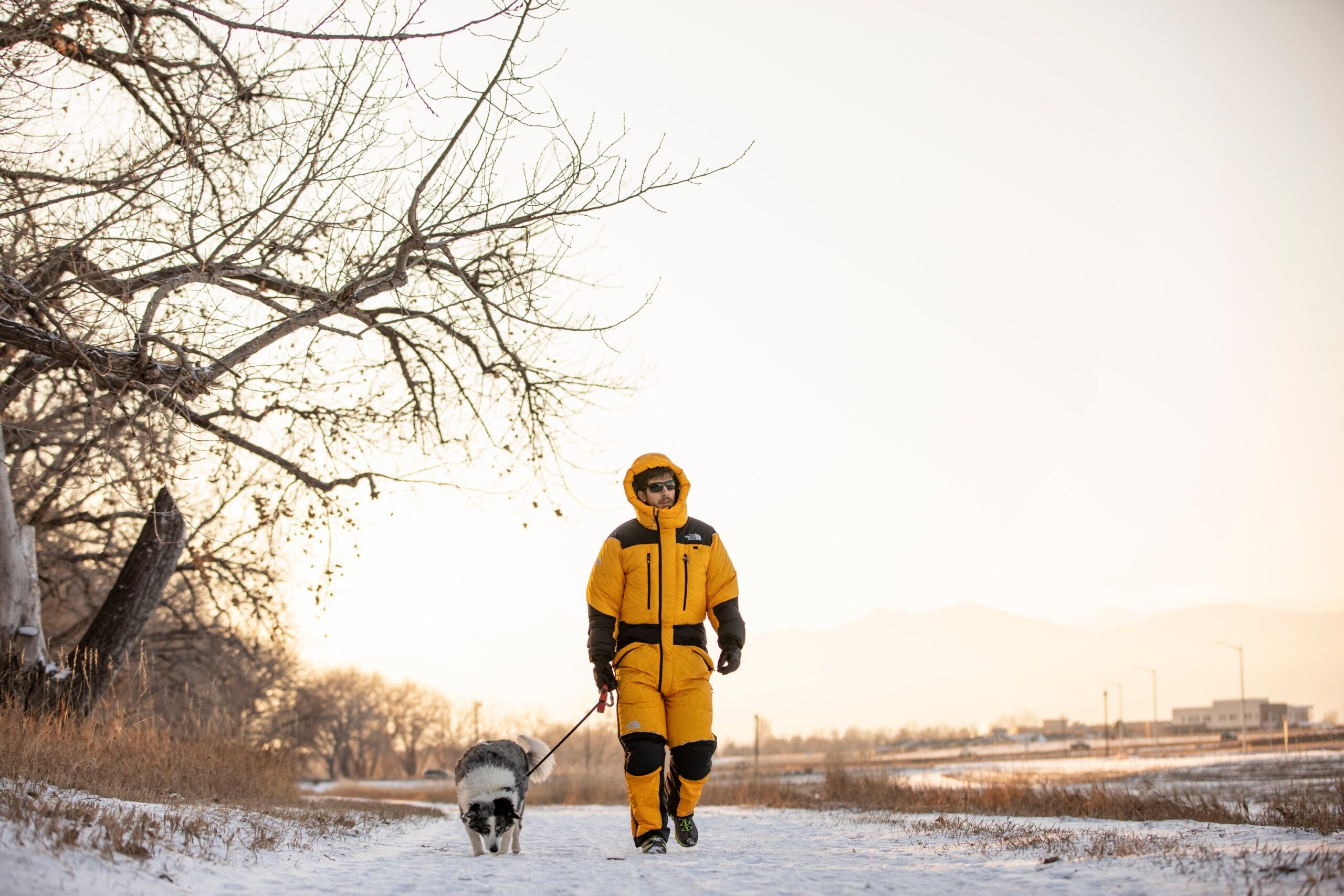Walmart was going to disrupt the outdoors. It was late August 2018, a year and a half after the retail leviathan purchased the online outdoor retailer Moosejaw for a reported $51 million. Walmart was ready to put its investment to work.
Walmart, as everyone knows, is the largest retailer on the planet. It sells everything from tire chains to whey protein at bargain-basement prices, but its focus in the outdoor space has always been more about car camping and hunting. Moosejaw, on the other hand, has sold high-end outdoor gear on its website for 27 years, growing its business from online only to 10 brick-and-mortar stores in the process. And now, with Walmart, it was poised to deliver on the industry’s long-held dream: to tap a staggeringly wider audience.
On March 10 2018, Moosejaw CEO Eoin Comerford told the Grand Rapids News that he was “very excited about the idea that [Moosejaw] can introduce high-end, premium outdoor products to people who perhaps have thought about getting into the outdoors, but haven’t been exposed to this product before.” Walmart spokeswoman Jaeme Laczkowski said at the time that walmart.com reached about 100 million unique visitors each month—a potential gold mine. It seemed like exclusive brands would finally go all the way mainstream, picking up millions of new customers and welcoming them to the party of those who live for and love playing outside.
That’s not what happened. On August 27, Walmart launched a “Premium Outdoor Store Curated by Moosejaw” on its website. Brands who’d agreed to be sold through the store included industry heavyweights like Deuter USA, Katadyn, Leki, and Therm-a-Rest among 50 other outdoor companies. But on launch day, one brand balked.
When the store went live, it advertised several Black Diamond products, including climbing slings, carabiners, ATC belay devices, and a harness. Within hours Black Diamond distributed a press release stating that it had directed Walmart to “cease and desist” use of the Black Diamond® and diamond logo trademarks because the store’s use of them was “likely to confuse consumers into believing that Walmart is an authorized dealer of Black Diamond.” Shortly thereafter, those four other high-end outdoor brands all pulled their products from the site, too.
The backpedaling was fierce and unexplained. Most brands gave canned answers that offered no insight into their thinking. Deuter USA president Bill Hartrampf said in a press release, “While we appreciate the concept of what Moosejaw is trying to accomplish with this new initiative, we have decided this is not the right time to participate.” It was all slightly strange, since when Moosejaw first introduced the premium store idea, at the Summer 2017 Outdoor Retailer show, several participating brands seemed excited. “The concept made sense,” Hartrampf told ���ϳԹ���. “We would be exposing our brand in a premium shop to a new, diverse group of consumers.”
But after Black Diamond’s response, Deuter USA, Katadyn, Leki, and Therm-a-Rest stood firm in their resolve to steer clear of selling directly on walmart.com.
So what happened? It had nothing to do with Moosejaw’s relationship with those retailers—all of them still do business with the e-tailer. And it had nothing to do with discounts—all products were listed full price. The catch seemed to be that these high-end outdoor products would now be marketed under the Walmart banner, and that clashed with how the brands viewed themselves.
In his statement, CEO John Walbrecht wrote, “Black Diamond remains committed to its specialty retail partners,” which, in an August 31 2018, column, Forbes analyst Chris Walton translated to mean: Black Diamond wanting to maintain its cachet “on the principle of scarcity.”
The wider problem, Walton added, was that “Walmart can’t escape its brand connotations.” Walbrecht declined to comment for this story.
Comerford, Moosejaw’s CEO, evidently thought that the way the entire situation played out whiffed of elitism. In an “Open Letter to the Outdoor Industry” published on his LinkedIn page, he argued that the Premium Outdoor Store was created “to grow the industry beyond its exclusionary, historical [white, male] audience” and echoed what has become a mantra in the outdoor industry: “If we’re going to grow this industry…we need to reach new audiences…younger, more female, more diverse.”
That’s true. But when the rubber met the road, the old troll named elitism emerged and with it, questions that have been plaguing the industry for years: Who are we? And perhaps more importantly, who �������’t we?
In some ways, that sense of elitism is what drew many people to the outdoors in the first place.
I know it enticed me, back when I was a kid first learning my way in the world, in the mountains of southern Idaho. When I hiked the trails outside of Ketchum, I reveled in the fact that so few people seemed to know the trails existed. When I fished the Wood River with my dad or camped in the South Hills with a boyfriend, I celebrated the beauty we saw because we were bold enough to earn it.
I’ve spent the ensuing 30-plus years living and recreating in a community of like-minded folks, and the outdoors have been central to who I am. And it’s not just me. A quick survey I posted on Facebook asking when friends first realized that the outdoors and the outdoor community was their “place” turned up several stories like mine.

Diehard mountain biker and former cycling tour operator Kelly Grebe answered, “I started riding my freshman year of college and oh my, I was addicted. There’s this community created when you can look at a fellow rider and know that they know what others do not.” This “secret frequency of stoke” Grebe experienced keeps her in the outdoor community that values isolated places and outdoor adventure.
But how to maintain that feeling when the outdoor spaces are busier and busier? Over the past three years, according to Outdoor Industry Association (OIA), participation in the outdoors has been on a slow but steady upswing. In 2017, 49 percent the U.S. population ages six and older participated in an outdoor activity at least once—and 13.6 million people tried outdoor activities for the first time or returned after a hiatus. Though 11.9 million people stopped participating last year, 1.7 million more people got out in 2017 than 2016 (the last year for which data are available).
The fastest-growing demographics are Hispanics and Asians, whose participation in activities like running, hiking, cycling, and camping has inched up about 1 percent over the last five years. But while the industry has been striving for greater inclusion, demographically speaking, the majority of outdoor users are white (74 percent) and 54 percent are male. Nearly one third of outdoor users have a college education, and a similar percentage has an annual household income greater than $100,000.
The second-largest grouping of outdoor users (22 percent) has less than three years of high school, and a similar percentage makes $25,000 to $49,999 annually. (The average Walmart shopper, by comparison, is a 50-year-old white woman with an annual household income of $53,125, according to a study by Kanter Retail in 2017.)

Outdoor brands, of course, have done well to market a relatable version of the outdoor ethos to the mass consumer. And not all brands herald “scarcity.” As they’ve grown, businesses like The North Face, Yeti, Marmot, and Spyder have increased their market share by selling outside specialty retail. Today, you can buy Spyder gear at Costco, a Yeti cooler at Sam’s Club, see a Patagonia Nano Puff vest on just about any guy who works in finance, and find more of The North Face on the quad than in basecamp.
Marketing is also pivoting from the elite to everyday. Merrell targets consumers who have real lives yet still enjoy being outside. Particularly popular are ambassadors who juggle full-time or multiple jobs while getting outdoors.
For Merrell, the decision to skew to a wider audience was an easy one. “People say hike is the new yoga,” said Strick Walker, Merrell’s chief marketing officer. “For us, this means making footwear and apparel for the trail. It also means inspiring folks to get out there—all folks.”
Anecdotally, the message is resonating with its target audience. “It’s difficult to track sales specifically from our DEI efforts,” he said. “What I do know is that the brand is growing and we have a clear mission. We know who we are, we love our ambassadors, and we will continue to tell stories about interesting people living interesting lives in the outdoors.”
Lifestyle is a much bigger component of the industry than technical is. And maybe by viewing it that way—lifestyle first—it’s easier to understand how and where the industry needs to position itself to grow.
By wearing Patagonia, you can align yourself with the brand’s political and environmental work, even if you’ve never set foot in Utah, caught a wave in California, or fly-fished a day in your life. Black Diamond jackets bestow the aura of elite upon their wearers—even on the sidelines at soccer practice. Yeti coolers are a potent status symbol, whether you’re on the river or at a tailgate party.
Even without technical context, these things signify a certain value placed on outdoor experiences, a scrapper’s mindset for problem solving, and a view of the earth as something to be enjoyed and perhaps, protected. When it comes down to it, that’s not so different from what I felt all those years ago on the “secret” trails of Sun Valley, and what I still feel to this day.
That’s certainly one argument for adopting an industry stance around inclusion rather than the exclusion that elitism implies. And that brings this whole thing back around to Walmart.
The millions of people who visit walmart.com are potentially millions of untapped outdoor users. And we need users, said Steve Barker, the founder of Eagle Creek and current Outdoor Foundation board member, to protect the outdoors and the environment. Though OIA’s statistics show an increase in overall outdoor participation, they also reveal a “leaky bucket.” While 10.6 million Americans returned to or started participating in one or more of the outdoor activities measured, 8.6 million stopped. That equates to a net gain of 2 million total participants and a churn rate of 8.3 percent.
We can’t continue to leak, Barker said, or fewer people will experience the outdoors, appreciate it, and advocate for its protection. That’s where Walmart could come in. “There’s always been a variety of entry levels for the consumer wanting to get into camping,” Barker added. “If Walmart is having that conversation, then we need to engage them at a deeper level.”
But Rich Hill, president of Grassroots Outdoor Alliance, pointed out that having a good first experience with the outdoors is paramount for new customers—that’s the reason they keep coming back—but that’s something Walmart or Amazon can’t offer. Moreover, Hill said big-box retailers could put the entire industry at risk because they don’t understand how safety equipment works. “A store like Amazon or Walmart is going to get someone killed,” he said.
Hill realizes that sounds elitist, but, in his view, the outdoor industry has a responsibility to keep people safe. “If that excludes some people from getting into the outdoors,” he said, “then so be it.”
While the connection between those who use the outdoors and those who advocate for it is notoriously difficult to quantify, there is no other widely accepted rationale for why it’s important to bring more people to our public lands. So let me offer one: all us lovers of the outdoors share something in common. Our connection to the wilds has to be earned individual by individual. But once it is, it doesn’t really go away. The world can do worse than to have more people feeling the outdoors in their chests and wearing it on their bodies—and the future of the industry likely depends on it, too.
In the end, there’s probably room for both elitism and mass consumerism in the outdoor industry without one devouring the other. We’re just going to need a bigger tent.


